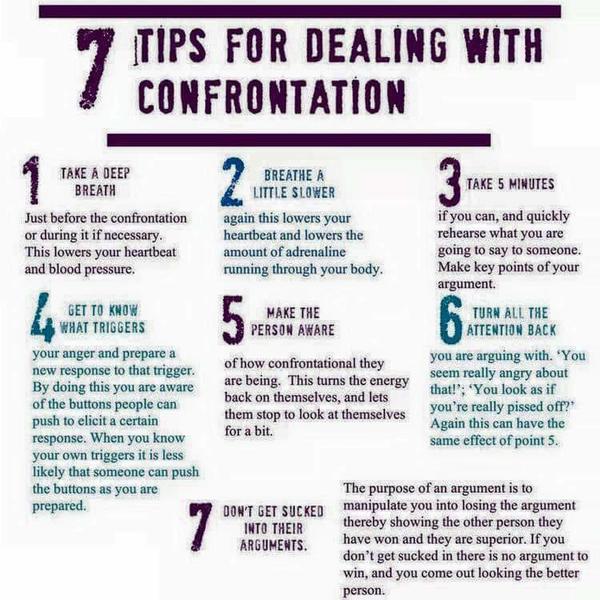Is this picture reflecting a trauma informed conflict resolution process? Why or why not?
Replies sorted oldest to newest
Interesting graphic which seems to encourage the user to approach conflict from a "get 'em before they get you" perspective. It started losing me at the end of #4 and completely lost me at #5. How does the developer operationally define "confrontation" and what is the developer's logic about the purpose(s) of confrontation? The graphic seems to suggest that "arguments" are by definition manipulation rather than the verbal expression of divergent points of view/goals....which may or may not invoke the tool of "manipulation." I find it more useful to understand the intentional or unintentional effect/end and/or desired outcome of each divergent point of view. Isn't that what we advocates of trauma-informed care are all about...establish where we are (personally, relationally, structurally/institutionally), how we got there/here (personal, relational, structural/institutional inputs), and illuminate/co-construct/facilitate a healthier place/ways to be (personally, relationally, structurally/institutionally)?
To point #7, I would suggest it's not just about "winning" but about something more significant and direct than "winning"...winning what/maintaining what/avoiding what/accomplishing what, etc? Fundamentally, I don't view confrontation as "winning," per se. I see "conflict" as absolutely necessary in improving (the only reality there is) perceived sub-optimal circumstances and "resolution" as illuminating/co-constructing/facilitating optimal alternatives. More nuanced discernment about purposes in the design/logic of the graphic might approach a more empowered (i.e. not about you "losing" the argument; not saying "people pushing your buttons") and, (perhaps) a more trauma-informed conflict resolution approach. Might users of the graphic be better served by a graphic that does not conflate the purpose(s) of confrontation. Need there only be one graphic about confrontation, since, logically speaking there may be multiple and cross purposes for confrontation? Hope those points are helpful.
I didn't make the graphic, a group I am trying to advocate to posted it on their Facebook page.
I felt like this was graphic is about sweeping conflict under the rug, denying voice, telling someone what is wrong with them instead of asking them. Not admitting they might have a valid point of view. It's exactly the way a person in power would handle conflict with someone they want to get rid and make shut up.
Unfortunately, the group who posted this graphic has handled all my advocacy efforts with them the same exact way.
Corinna,
Based on your previous inputs in this community I was confident that you didn't make the graphic. I agree that the graphic is very much about power (ALL engagements are). Specifically, the graphic reinforces the power to oppress, rather than "power to resist oppression," rather than "power to foster liberation," and rather than "power to promote wellness" (see Isaac Prilleltensky's work in Critical Community Psychology).
Does the group you are working with use a monitoring and evaluation methodology in their program processes? I'll go out on a limb and suggest that, it would seem perhaps education (illumination) or even backward chaining (if your expertise is contracted) may be viable first steps since their approach to dissent, apparently, may follow their graphic's advice.
Pamela, Thank You for adding your insights and wisdom to this discussion, and I would concur with you on those points.


